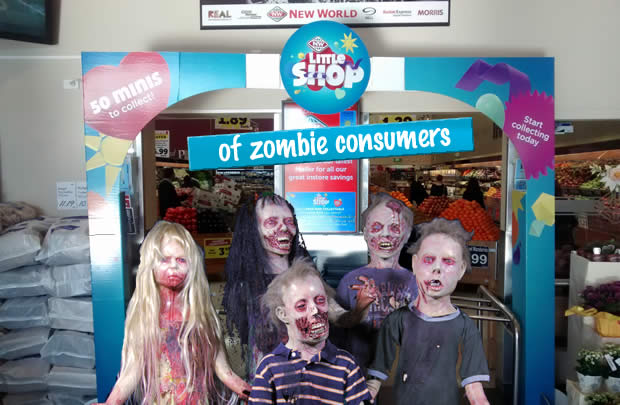Parents will know the pester power unleashed by offering collectables such as toys (or in the case of Countdown, cards). This tactic has long been used by fast food companies to lure in kids. Now it is being used as part of the war between the supermarket duopoly.
The power of peer pressure in the playground is plain for all to see. This is why advertisers use this trick so much – international fast food restaurants spend over half their marketing budget for kids on toys. It works – handing out toys or using cartoon characters on packaging has been shown to influence children’s tastes and food preferences. It is a perfect way to cultivate a lifetime of addiction – sorry, brand loyalty.
A lot of Kiwis think that the food we eat is a matter of personal responsibility. If that is the case, how can we stand by and allow food companies to cultivate tastes so early? What chance do our kids have of leading a healthy life?
This ‘Little Shop’ promotion was so successful for New World the first time around, they’ve brought it back. And why wouldn’t they? Food manufacturers are falling over each other to get their foods immortalised in the form of a plastic miniature. It gets people in the door, and probably makes money for New World to boot.
The problem is that, like most advertising, only the companies that can afford it will take part. Those are the companies with bigger margins, which usually means they are selling highly processed food, stripped of nutrients and packed full of sugar, fat and salt. That is the only way to make food sit on the shelf for so long without going off, which makes the food cheaper to sell, which leaves room for an advertising budget.
As a result, many of the brands being pushed in the Little Shop are of questionable nutrition value:
- Weet Bix Bites are 22% sugar,
- Pams jam strawberry is 66.1% sugar,
- Chicago Meatlovers Pizza 800Kj per serve (But will you just eat one slice? There are 8 serves in a whole pizza – so if you eat the whole thing that is ¾ of a days worth of food!),
- Tasti Apricot Snack Logs are 39.9% sugar,
- Keri Orange Juice has ¾ of the sugar of Coke,
- A 420g can of baked beans contains 7 teaspoons of sugar,
- Maxx Chips are 31% fat,
- M&Ms, Griffins Hundreds and Thousands biscuits and Jellytip ice cream are all clearly junk food with high levels of sugar and fat.
Why are we allowing these products to advertise directly to kids? The answer is that past and present governments have set up a weak kneed system of self-regulation for food advertising to kids. There are so many loopholes in it, it’s not funny. Toys are one of those loopholes. The companies involved can make pronouncements that they ‘abide by the code of conduct’, then advertise to kids through the back door.
A University of Otago researcher has called for a ban on manipulative junk food advertising to kids. We agree – advertising junk food to our youngest and most vulnerable citizens should be completely off the menu, as happens in Norway.
[box type=”note”]Petition: Make easy to understand, front of pack nutrition food labeling compulsory in New Zealand | Sign Now[/box]

